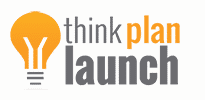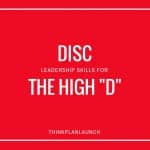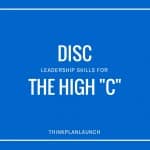DISC for Managers and Leaders
Leadership is about communication and behavior
DISC is a proven way to enhance leadership. Dale Carnegie proposed that those who want to be successful in life and in business must know how to deal with people. Make no mistake, communication and behavior is everything for the aspiring manager and executive. In fact, effective leadership is essential for managing the millennial worker.
DISC helps leaders communicate better. Communication can be verbal or nonverbal and direct or indirect. All of these forms of communication can be powerful if used in the right way. A manager must know when to use each type of communication and more specifically how to communicate in order to be a more effective leader. Communication channels also become of importance as well. A meeting, email, or memo can convey different things to different people. Perception dictates the success of each instance of communication. DISC can help a leader choose the best method to communicate.
Also, communication is two ways. Listening becomes a powerful tool for leaders to receive feedback, intelligence, and insight. For a manager to increase influence, there needs to be a way of maximizing communication and avoiding communication pitfalls. Like anything, however, there needs to be a careful balance. Too little can be ineffective. Too much can be distracting and lead to overload. In DISC, we can understand who is more susceptible to one-way communication.
The second part of leadership involves behavior and DISC is all about it. The behavior a leader displays can influence in a variety of ways. The behavior of managers can motivate and encourage. It can increase confidence and morale. And if the behavior is not favorable, it can create stress, low morale, and decrease productivity all of which becomes a big headache for HR and CFOs who must deal with high turnover rates in dysfunctional organizations.
Fortunately, behavior can be analyzed and predicted through a DISC assessment. Behavioral styles can be assessed and measured for a leader and the team. With the knowledge in hand, behavior can be shaped into a powerful and influential tool for effecting action. Motivation, enthusiasm, confidence, and respect can be had with the right behavioral tactics. Leaders must understand their own behavior and adjust their communication styles.
Where DISC comes to play
DISC is a universal language of observable behavior. Because it is a language, its components can be defined. In the case of DISC, there are four main styles of behavior which makes up DISC. It is measurable through assessments and through observation by a professional behavioral analyst. Each DISC style comprises of different behavior and communication styles. A person usually scores high in one or more of these styles indicating their natural behavior.
Once a person knows their DISC style, they can understand their major strengths and weaknesses associated with each style. It essentially uncovers a person’s blind spots and empowers them with higher-self awareness. What makes it even more powerful, is when a leader knows the DISC behavioral styles of their team. To illustrate this concept, we’ll look at an example.
Go back to your high school days and imagine two groups of people. The football team and the science club (or any two groups that normally seem on the opposite end of the behavior spectrum. Before we fall into the pitfalls of making snap judgments about which group has greater power or influence, we must understand that of the four DISC behavior types, there is no superior style that makes a person a better leader. In fact, among the US presidents, you will find all DISC types present.
Now, with all bias removed, focus on the leaders of these two groups. Both leaders most likely possess similar behavior, attitudes, and personalities as their team members, but probably have superior communication skills than average (though of vastly different ways). Ask your self the question, is it possible for the leaders of these two groups to switch and still function as an effective leader? Probably not. Actually, almost definitely not. It is laughable even. A science club president would barely get a word through in a locker room meeting and a football captain would probably be too direct when communicating to the science club. However, with the right adjustments, it would be possible for each person to cope with the different groups. DISC can identify which adjustments are needed for each leader to cope with different groups of people.
While this high school analogy is a bit extreme in terms of the different groups involved, an office setting can usually bring together people of all DISC types into one team making it more complicated but not impossible for a manager to adapt to each person’s DISC style.
DISC for leaders allows managers to tailor their behavior and communication for each DISC style. Mirroring and adaption increases their ability to influence each DISC type. Though it might seem bizarre to think of a science club president hounding at a team of athletes, with practice and advice, it is possible.
A person who understands DISC and its implementation can increase their influence and make them a more effective leader.
Why leaders should use DISC?
There are a number of behavioral assessments, personality tests, psychological questionnaires (Myers-Briggs Personality Indicator) Buzzfeed quizzes out there, why is DISC the best system for leaders?
- It is a universal language – DISC can be applied to any country, culture, language, industry, and group. Observable behavior comes from the human element rather than the environment which influences how behavior is triggered rather than how behavior is formed.
- Simple, yet powerful – There are only four DISC types but each person possesses some level of each type which creates a large amount of different behavior profiles. This system is easy to understand and easier to use with guidance.
- Actionable – Unlike other systems, DISC is actionable. The assessment tests give objective insight into a person’s strengths and weaknesses. A good DISC behavioral analyst will also be able to guide a person to use their DISC analyst to the best of its use. It isn’t a “feel-good” type of test that we see spread around the internet these days.
- Accurate – DISC has been around for decades and it has been proven in its accuracy and its applications have been constantly revised and tweaked through careful analysis of large data sets. Some tests such as Myers-Briggs have proven to be inconsistent.
- Influential – The use of DISC increases a leader’s ability to influence others through behavior and communication.
- Adaptable – DISC can be used in any organization no matter what size or sector. As a universal language it has wide applications and can give a great competitive edge.
Learn more about each DISC Type
High-D
The “dominant” High-D leader is direct, forceful, and to the point. This leader is one who strives for results. Learn more about how the High-D leader gets things done or how the High-D in general behaves and communicates.
High-I
The “influencing” High-I leader motivates their team and uses people skills to bring about action. This leader is people-focused and can rally a group easily. Learn more about this type of leader or find out more about the High-I in general.
High-S
The “steady” High-S is a leader who supportive, reliable and a great team player. This leader is also people orientated but has a poker face which can throw off the competition. Dive into the details of this leader or get a recap on the High-S.
High-C
The “compliant” High-C leader is calculating, analytical, and accurate. As a leader, the High-C sets a high standard and strives to be detailed and complete. Learn more about this DISC type or get some general information on the High-C.
Don’t know your DISC type?
If you haven’t already found out which DISC type(s) you are, no problem. There are a number or local and online DISC assessment providers such as ourselves, which can help you figure out which DISC type you are. It is also important to consider the DISC types of your team as well to get the best benefit out of it. You can always try a free DISC assessment before you are ready to bring your team up to speed.




